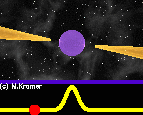Astrophysik: Gravitationsdetektoren
Using computers to hunt for gravitational waves

Even for the best of the current detectors, all gravitational wave signals are well-hidden in the noise from sources as various as seismic vibrations and the quantum structure of light. That's why computer-aided analysis is indispensable - a systematic search for characteristic gravitational wave signals among the noise dominating the detector output. However, the computational cost is high: For instance, the periodic wave signal from a rotating neutron star (see animation) with a slight irregularity that makes it radiate gravitational waves varies, depending on how fast the star rotates and on its position in the sky. An ordinary personal computer would take about 5000 years to look for all suitable variations of this signals in the data generated by a gravitational wave detector within one week.
[ Sitemap ]
[ info ] This website was created by the MPI for the History of Science.
 Scene
Scene


 1st Slide
1st Slide
 Branching Point
Branching Point
 Module: Astrophysik: Gravitationsdetektoren
Module: Astrophysik: Gravitationsdetektoren Sequence: Gravitationswellendetektoren Einstieg
Sequence: Gravitationswellendetektoren Einstieg Branching Point: Gravitational wave detectors
Branching Point: Gravitational wave detectors Slide: Detecting gravitational waves
Slide: Detecting gravitational waves
